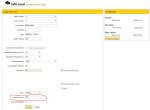Hello,
One of the benefits Flux Vector Drives (variable frequency drives) is that the normal 6x of FLA or so inrush current for motors is limited. A typical value that the inrush is limited to is 110% of FLA.
Looking at the Caterpillar gen sizer program, they have an option to list how the motor is started and a VFD is available. However, the there is a field that allows to mark what percentage the input current is limited to. The default is 110%. Suppose the motor at start needs to move a high inertia load, and maintain 150% FLT for 60 seconds, assume the drive is properly sized and can provide this, what would the input current to the drive look like? Would it still limit the input current to a maximum of 110%, or will it trip out and this setting will need to be adjusted for this application?
In other words, depending on the torque producing current, magnetizing current, and the Pythagorean theorem there will be some sort of output current draw proportional to the 150% FLT, but what about the input?
One of the benefits Flux Vector Drives (variable frequency drives) is that the normal 6x of FLA or so inrush current for motors is limited. A typical value that the inrush is limited to is 110% of FLA.
Looking at the Caterpillar gen sizer program, they have an option to list how the motor is started and a VFD is available. However, the there is a field that allows to mark what percentage the input current is limited to. The default is 110%. Suppose the motor at start needs to move a high inertia load, and maintain 150% FLT for 60 seconds, assume the drive is properly sized and can provide this, what would the input current to the drive look like? Would it still limit the input current to a maximum of 110%, or will it trip out and this setting will need to be adjusted for this application?
In other words, depending on the torque producing current, magnetizing current, and the Pythagorean theorem there will be some sort of output current draw proportional to the 150% FLT, but what about the input?

